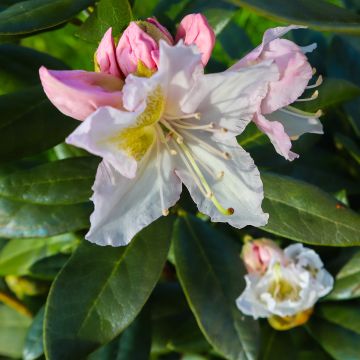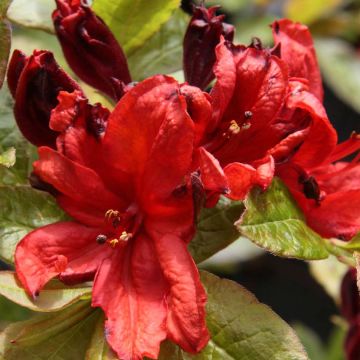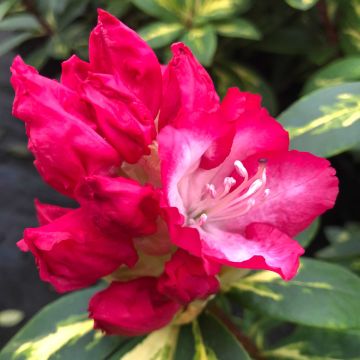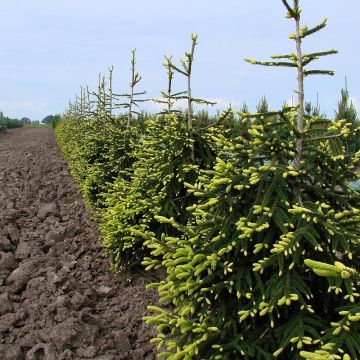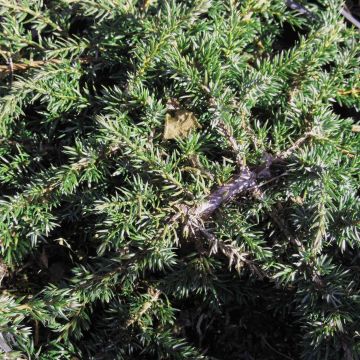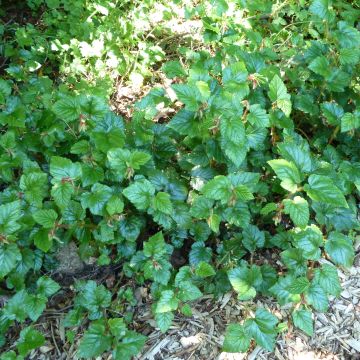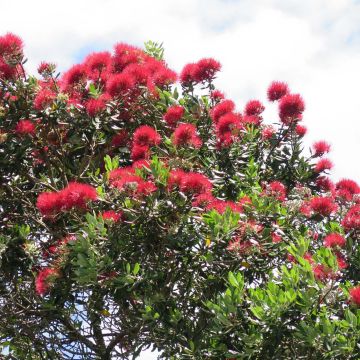

Rhododendron catawbiense Boursault


Rhododendron catawbiense Boursault


Rhododendron catawbiense Boursault
Rhododendron catawbiense Boursault
Rhododendron catawbiense Boursault
Rhododendron hybride
This item cannot be shipped to the selected country
Delivery charge from €5.90
Delivery charge from €5.90
More information
Delivery charge from €5.90
Delivery charge from €5.90
More information
Schedule delivery date,
and select date in basket
This plant carries a 24 months recovery warranty
More information
We guarantee the quality of our plants for a full growing cycle, and will replace at our expense any plant that fails to recover under normal climatic and planting conditions.
From €5.90 for pickup delivery and €6.90 for home delivery
Express home delivery from €8.90.
From €5.90 for pickup delivery and €6.90 for home delivery
Express home delivery from €8.90.
Does this plant fit my garden?
Set up your Plantfit profile →
Description
Rhododendron x catawbiense 'Boursault' is a vigorous bush that forms a rounded dome 2.50 m (8ft) high. The vegetation is covered in late spring with a magnificent mauve flowers, which stands out well against the dark green evergreen foliage. Very hardy, this large Rhododendron tolerates the sun well in northern regions, planted in slightly moist acidic soil. A magnificent heathland plant to be placed as a specimen or in a group, at the edge of large trees or to form unique hedges.
Rhododendrons are plants of the Ericaceae family, which includes many ornamental genera of great value, such as Heather (Erica and Calluna), Kalmia, Leucothoe, Oxydendrum, Gaultheria, and many others. The vast majority of these plants prefer soils devoid of limestone, with an acidic tendency, as well as humid and temperate climates in summer. Rhododendron catawbiense is a large species, native to the U.S.A, more precisely the mountain slopes of the southern Appalachians, which extend from Virginia to Georgia. It is characterised by remarkable resistance to cold and diseases that can affect these shrubs. Frequently planted in American gardens, it has been hybridised with species native to the less hardy Himalayas to produce some of our most spectacular rhododendrons.
'Boursault' is a very old variety, introduced to the market before 1850, and certainly one of the best known. This Rhododendron forms a large bush with a rounded habit, wider than it is tall. Its growth is relatively fast, reaching 1.75 m (6ft) to 2 m (7ft) in height in ten years, and then continuing to grow to at least 2.50 m (8ft) in height and 3 m (10ft) in spread under good conditions. The branches are abundantly adorned with beautiful dark green glossy foliage, composed of evergreen elliptical leaves. The flowering, particularly luxuriant, begins at the end of May and lasts for almost a month. The large funnel-shaped flowers are gathered in absolutely magnificent spherical clusters, well highlighted by the dark foliage. The colour of the flowers, a bright mauve with a small yellow-orange macule, is particularly bright in semi-shaded situations.
Rhododendron catawbiense 'Boursault' is a plant that offers a great spectacle, and is also decorative outside of flowering with its graphic habit, rounding with age. Planted as a specimen on a lawn, it will be a point of interest in spring. It can be planted in the background of superb Kalmias, or Mountain Laurels, with their colourful blooms, or Japanese Andromedas (Pieris) with delicate bell-shaped flowers. For a floral scene, it can be associated with the essential Camellias, whose numerous varieties ensure months of flowering.
Rhododendron catawbiense Boursault in pictures




Plant habit
Flowering
Foliage
Botanical data
Rhododendron
catawbiense
Boursault
Ericaceae
Rhododendron hybride
Cultivar or hybrid
Other Large Rhododendrons
Planting and care
Plant Rhododendron catawbiense 'Boursault' in a semi-shaded position, protected from cold and drying winds, in a damp, humus-rich, and light soil with an acidic tendency. Like all plants in the heath family, it does not tolerate limestone soils or heavy soils saturated with water in winter. Dig a hole three times larger than the pot. Soak the root ball in non-calcareous water and plant the shrub at the level of the collar, in a mixture composed of 1/4 compost, humus, gravel or pumice, and loam. Water generously and keep the soil moist in summer.
Azaleas and Rhododendrons have a shallow and relatively limited root system. Therefore, they are sensitive to long periods of drought. That is why it is recommended to enrich the soil with humus beforehand and water abundantly with non-calcareous water during dry periods. In addition, this root system is not very strong, which is why it is essential to lighten heavy soils with draining materials (gravel, pumice, clay pellets) when planting. Apply a mulch of shredded pine bark around the base of the bush every spring to maintain soil moisture while keeping an acidic pH.
Maintenance involves removing old faded flowers in summer using pruning shears and clearing the plant of dead branches. Azaleas and Rhododendrons can sometimes be attacked by weevils that eat the edges of leaves and rootlets, as well as the infamous "rhododendron beetle" which does not often cause significant damage. Yellowing of the leaves (chlorosis) in Rhododendrons indicates poor iron assimilation in the soil and can lead to the premature death of the plant. While limestone is generally the cause, poorly-drained soil or deeply planted root balls can also explain the phenomenon.
Planting period
Intended location
Care
This item has not been reviewed yet - be the first to leave a review about it.
Evergreen shrubs
Haven't found what you were looking for?
Hardiness is the lowest winter temperature a plant can endure without suffering serious damage or even dying. However, hardiness is affected by location (a sheltered area, such as a patio), protection (winter cover) and soil type (hardiness is improved by well-drained soil).

Photo Sharing Terms & Conditions
In order to encourage gardeners to interact and share their experiences, Promesse de fleurs offers various media enabling content to be uploaded onto its Site - in particular via the ‘Photo sharing’ module.
The User agrees to refrain from:
- Posting any content that is illegal, prejudicial, insulting, racist, inciteful to hatred, revisionist, contrary to public decency, that infringes on privacy or on the privacy rights of third parties, in particular the publicity rights of persons and goods, intellectual property rights, or the right to privacy.
- Submitting content on behalf of a third party;
- Impersonate the identity of a third party and/or publish any personal information about a third party;
In general, the User undertakes to refrain from any unethical behaviour.
All Content (in particular text, comments, files, images, photos, videos, creative works, etc.), which may be subject to property or intellectual property rights, image or other private rights, shall remain the property of the User, subject to the limited rights granted by the terms of the licence granted by Promesse de fleurs as stated below. Users are at liberty to publish or not to publish such Content on the Site, notably via the ‘Photo Sharing’ facility, and accept that this Content shall be made public and freely accessible, notably on the Internet.
Users further acknowledge, undertake to have ,and guarantee that they hold all necessary rights and permissions to publish such material on the Site, in particular with regard to the legislation in force pertaining to any privacy, property, intellectual property, image, or contractual rights, or rights of any other nature. By publishing such Content on the Site, Users acknowledge accepting full liability as publishers of the Content within the meaning of the law, and grant Promesse de fleurs, free of charge, an inclusive, worldwide licence for the said Content for the entire duration of its publication, including all reproduction, representation, up/downloading, displaying, performing, transmission, and storage rights.
Users also grant permission for their name to be linked to the Content and accept that this link may not always be made available.
By engaging in posting material, Users consent to their Content becoming automatically accessible on the Internet, in particular on other sites and/or blogs and/or web pages of the Promesse de fleurs site, including in particular social pages and the Promesse de fleurs catalogue.
Users may secure the removal of entrusted content free of charge by issuing a simple request via our contact form.

































